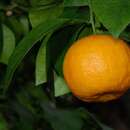en
names in breadcrumbs


Citrus myrtifolia, the myrtle-leaved orange tree, is a species of Citrus with foliage similar to that of the common myrtle. It is a compact tree with small leaves and no thorns which grows to a height of three metres (10 ft) and can be found in Malta, Libya, the south of France, and Italy (primarily in Liguria, typically Savona, and also in Tuscany, Sicily, and Calabria).
The fruit of the tree resemble small oranges. It has a bitter flavor and is commonly called by its Italian name, chinotto (Italian pronunciation: [kiˈnɔtto]). It is an essential flavoring agent of most Italian amari, of the popular Campari apéritif, and of several brands of carbonated soft drinks that are generically called "chinotto".
Citrus myrtifolia is sometimes planted in gardens. Due to its compactness, it can also be planted in a pot or other container.


Citrus myrtifolia, the myrtle-leaved orange tree, is a species of Citrus with foliage similar to that of the common myrtle. It is a compact tree with small leaves and no thorns which grows to a height of three metres (10 ft) and can be found in Malta, Libya, the south of France, and Italy (primarily in Liguria, typically Savona, and also in Tuscany, Sicily, and Calabria).
The fruit of the tree resemble small oranges. It has a bitter flavor and is commonly called by its Italian name, chinotto (Italian pronunciation: [kiˈnɔtto]). It is an essential flavoring agent of most Italian amari, of the popular Campari apéritif, and of several brands of carbonated soft drinks that are generically called "chinotto".
Citrus myrtifolia is sometimes planted in gardens. Due to its compactness, it can also be planted in a pot or other container.
 Chinotto at the Botanical Garden of the Brissago Islands
Chinotto at the Botanical Garden of the Brissago Islands